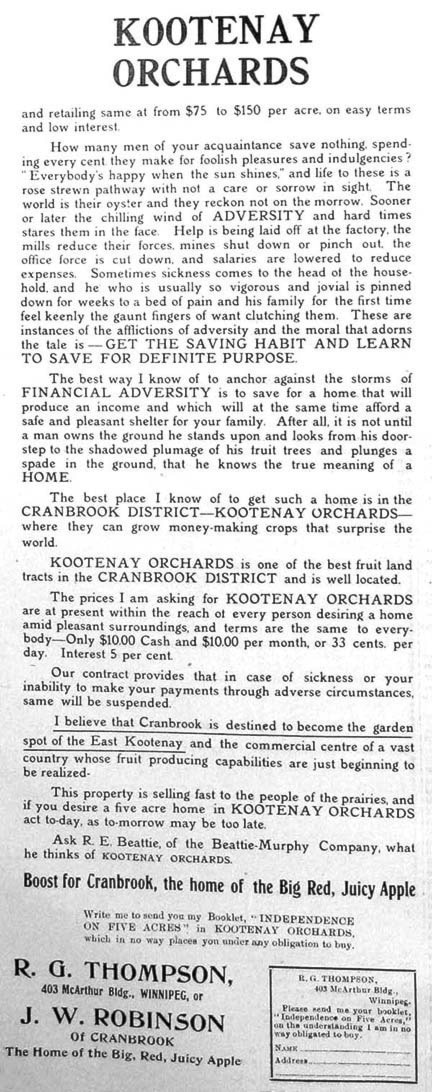Jim Cameron
"Round about the time I hit these parts (in 1915) one could see these abandoned places scattered here and there all around the district — a small clearing planted with fruit trees now dead or dying, an empty house probably with broken windows ... the land neglected and gradually going back to mother nature." — Dave Kay, Cranbrook Courier, May 25, 1966
From its inception in 1898 Cranbrook was known as many things but never, then or now, as a centre for fruit farming. Never, that is, with the exception of the period of 1908-1916.
In 1908, F.E. Simpson began a dedicated and highly questionable campaign in his Cranbrook Herald newspaper to endorse, of all things, local fruit farming. The early days of Cranbrook saw a number of land speculators buying up large chunks of property, many of which sat idle for years. The idea caught on and soon five-acre lots surrounding the town appeared on the market in large quantities.
Kennedy's pre-emption of 320 acres between Cranbrook and Jim Smith Lake was split into five acre lots and declared "Appleland." Hyde Baker subdivided 800 acres which, added to the Horie subdivision, the large Dulmage ranch, the Hill subdivision and assorted lands offered by local realtors Beale & Elwell, brought nearly 2,000 acres of land onto the market, all of which, according to the sellers' advertisements and Editor Simpson's editorials, offered a local fruit farming wonderland.
Mr. Simpson retired from the newspaper and left town in late 1909 which may well have been the end of it had it not been for J.W. Robinson, of the former Robinson-Mackenzie lumber mill, and W.C. Shields, another local landowner, deciding to put a great deal of property up for sale in March, 1912, under the banner of "Kootenay Orchards." They advertised heavily, both locally and back east, and the properties began selling to people from Canada, U.S. and abroad.
All was not as it seemed, however, and within a few weeks the local Board of Trade (the precursor of the Chamber of Commerce) called an emergency meeting to deal with a letter circulating across Canada in which one E.R. McMahen wrote to Mr. J. Doherty of Kenora, Ontario: "In reply to your letter I would say that I have been offered forty acres, twenty acres clear of stumps, root, one horse and buggy, one hundred chickens, thirty apple trees, a house and stable on it for $1600. This man has lived here for eight years and could not raise enough to live on and he is in as good a location as I know of ... but frost or drought overcomes everything. Would advise you to come see the situation before you invest any money."
What appears as reasonable advice was viewed by the board of trade as a slanderous statement. Mr. McMahen's advice was either ignored or unknown to a number of people who purchased land between what is still known as Kootenay Orchards and Sylvan Lake in the present day Community Forest, the approximate boundaries of the Kootenay Orchards subdivision. How many purchased under the false hope of raising fruit is unknown, perhaps as many as 40. Suffice to say there were enough people in the area to petition the local school board for a school, which was opened in 1914.
What exactly happens when people buy land under false pretenses such as these? Well, in 1916, Mr. R.T. Williams, on behalf of a number of Kootenay Orchards settlers, launched a "test" case against Mr. Shields. The case was heard before Justice Clement in the Cranbrook Supreme Court in June, 1916. The plaintiff (Williams) sought the dissolution of his purchase contract with the defendant (Shields), claiming damages for fraudulent representations at the time of sale by the vendor and his agents and in literature sent out by the same. The vendors offered to reduce the price by one half which was refused.
Among the evidence was at least one photo titled "Cranbrook fruit in Kootenay Orchards" which the plaintiff claimed was of Creston fruit exhibited at the Cranbrook Fall Fair.
The four-day hearing included a large number of witnesses called by both sides with a large amount of evidence given. Justice Clement reserved judgment until October of that year at which point he stated that he could not set aside the contract in view of the long delay on the part of Mr. Williams in taking steps to obtain redress, Williams having bought the property in 1912, but he did state the following: "I am confirmed in the view which I had formed ... that the plaintiff had been the victim of a gross and cruel fraud. The prospectus upon the faith of which the plaintiff bought certain lots in 'Kootenany Orchards' from the defendant put forward certainly a most alluring picture; but the evidence shows [old spelling] clearly to my mind that it was as false as it was alluring. There is scarcely a statement as the nature of the soil, its fertility and water supply, as to cost of clearing, as to climatic conditions and as to actual results already achieved in the immediate neighbourhood that has not been shewn to be a perversion of the truth."
In short, Williams et al did not receive full redress in terms of cost and damages but did receive a reasonable reduction in the balance of costs owing. An appeal heard in Victoria in 1918 was dismissed. Needless to say, the decision ended the "Cranbrook-as-fruit-capital" era.
Kootenay Orchards remains today, a gentle reminder that for some of Cranbrook's pioneers, life was not always a bowl of cherries.
